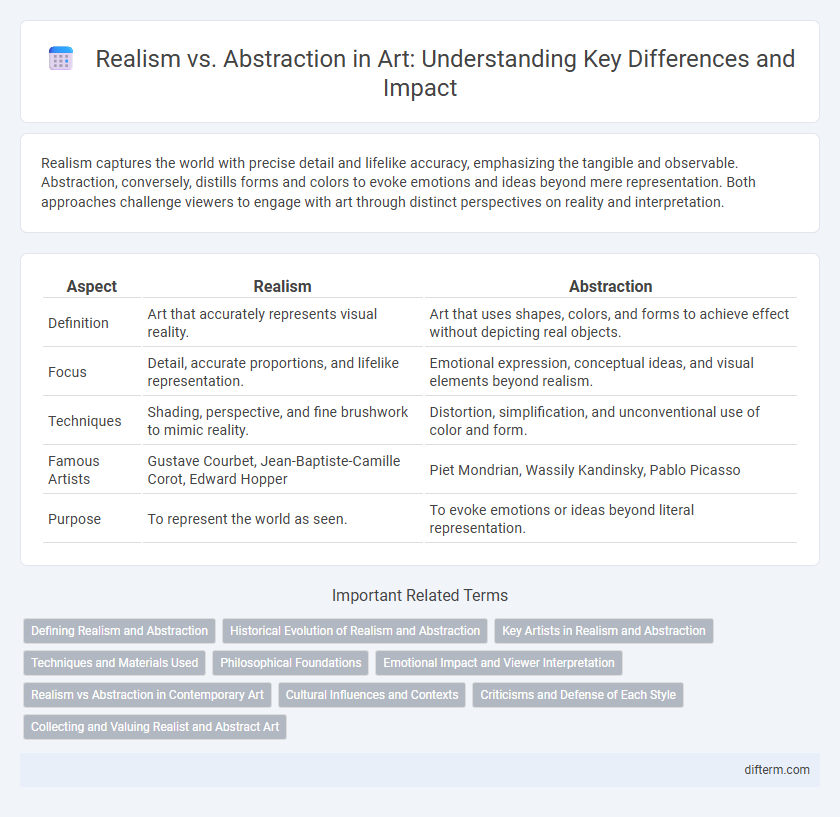Realism captures the world with precise detail and lifelike accuracy, emphasizing the tangible and observable. Abstraction, conversely, distills forms and colors to evoke emotions and ideas beyond mere representation. Both approaches challenge viewers to engage with art through distinct perspectives on reality and interpretation.
Table of Comparison
| Aspect | Realism | Abstraction |
|---|---|---|
| Definition | Art that accurately represents visual reality. | Art that uses shapes, colors, and forms to achieve effect without depicting real objects. |
| Focus | Detail, accurate proportions, and lifelike representation. | Emotional expression, conceptual ideas, and visual elements beyond realism. |
| Techniques | Shading, perspective, and fine brushwork to mimic reality. | Distortion, simplification, and unconventional use of color and form. |
| Famous Artists | Gustave Courbet, Jean-Baptiste-Camille Corot, Edward Hopper | Piet Mondrian, Wassily Kandinsky, Pablo Picasso |
| Purpose | To represent the world as seen. | To evoke emotions or ideas beyond literal representation. |
Defining Realism and Abstraction
Realism in art emphasizes accurate, detailed, and unembellished depiction of the visible world, capturing life as it appears without idealization. Abstraction, by contrast, distills forms to their essential shapes, colors, and emotions, often departing from recognizable subjects to evoke conceptual or sensory experiences. Defining realism involves prioritizing observational accuracy, while abstraction seeks to challenge perception through symbolic or non-representational imagery.
Historical Evolution of Realism and Abstraction
Realism in art emerged prominently in the mid-19th century, driven by artists like Gustave Courbet who sought to depict everyday life with precise detail and social commentary. Abstraction evolved in the early 20th century through pioneers such as Wassily Kandinsky and Piet Mondrian, emphasizing non-representational forms and emotional expression over literal depiction. This historical shift reflects changing philosophical and cultural attitudes toward the role of art in representing reality.
Key Artists in Realism and Abstraction
Gustave Courbet and Jean-Francois Millet are pivotal figures in Realism, emphasizing accurate depictions of everyday life and social conditions. In contrast, Wassily Kandinsky and Piet Mondrian pioneered abstraction, breaking away from representational art to explore emotion and form through color and geometric shapes. The divergence in their approaches highlights a fundamental shift in 19th and 20th-century art movements reflecting evolving cultural and philosophical ideals.
Techniques and Materials Used
Realism in art employs precise techniques such as fine brushwork, detailed layering, and accurate tonal gradation to depict subjects with lifelike accuracy, often using traditional materials like oil paints and canvas for richness and texture. Abstraction focuses on experimental methods, utilizing diverse materials including mixed media, acrylics, and unconventional objects, emphasizing texture, shape, and color over representational accuracy. Both styles exploit unique techniques and material choices to convey distinct artistic visions and emotional impacts.
Philosophical Foundations
Realism in art emphasizes accurate, detailed representation of the visual world, rooted in the philosophy of empiricism that values sensory experience as the foundation of knowledge. Abstraction, influenced by idealism and phenomenology, explores subjective interpretation and the essence beyond physical appearances, challenging the notion of objective reality. This philosophical dichotomy drives continuous dialogue on perception, truth, and the role of the artist in conveying meaning.
Emotional Impact and Viewer Interpretation
Realism in art captures precise details and familiar scenes, fostering a direct emotional connection by mirroring real-life experiences, which often leads viewers to a shared understanding and empathy. Abstraction, by distorting or simplifying forms, invites diverse interpretations, provoking introspection and emotional responses that vary widely among individuals. The contrast between these art styles highlights how emotional impact is shaped either by concrete representation or by subjective viewer interpretation.
Realism vs Abstraction in Contemporary Art
Realism in contemporary art prioritizes accurate, detailed representation of the visible world, emphasizing lifelike depictions and tangible subjects to evoke direct emotional responses. In contrast, abstraction distills forms and colors, removing representational elements to explore conceptual ideas, emotions, and visual language beyond literal interpretation. Both approaches challenge viewers differently, with realism offering clarity and familiarity, while abstraction invites personal interpretation and imaginative engagement.
Cultural Influences and Contexts
Realism in art often reflects cultural traditions and societal values, grounding its imagery in recognizable forms and historical narratives that resonate with specific communities. Abstraction challenges these conventional representations by emphasizing emotional expression and individual perception, shaped by modernist movements and shifting cultural landscapes. The tension between realism and abstraction highlights diverse cultural influences, revealing how context, ideology, and social change shape artistic interpretation and visual language.
Criticisms and Defense of Each Style
Realism faces criticism for its perceived lack of creativity and reliance on precise representation, often seen as limiting artistic expression. Defenders argue that its detailed depiction of everyday life offers powerful social commentary and emotional depth. Conversely, abstraction is criticized for being inaccessible and overly subjective, yet proponents emphasize its ability to evoke universal emotions and encourage personal interpretation beyond literal forms.
Collecting and Valuing Realist and Abstract Art
Collectors often prioritize realism for its detailed representation and emotional resonance, valuing works that capture lifelike precision and narrative clarity. Abstract art commands attention through its emphasis on form, color, and conceptual depth, appealing to those who appreciate interpretive freedom and innovation. Market trends reveal a growing appreciation for both styles, with realism commanding strong demand in traditional circles and abstraction thriving in contemporary and avant-garde spaces.
realism vs abstraction Infographic

 difterm.com
difterm.com